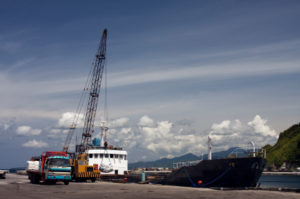 Philippine Ports Authority (PPA) has issued uniform port tariffs for use as base tariff on contracts categorized as Tier 3 under the agency’s new terminal management policy.
Philippine Ports Authority (PPA) has issued uniform port tariffs for use as base tariff on contracts categorized as Tier 3 under the agency’s new terminal management policy.
PPA Administrative Order (AO) No. 10-2019, which took effect on November 10, declares that the new tariffs will apply once the PPA’s Port Terminal Management Regulatory Framework (PTMRF) is implemented and a contract entered into with the winning bidder/concessionaire.
For terminal operators and cargo-handling operators with existing development, management, and operations contract and cargo-handling service contract, they will use the existing cargo-handling tariff indicated in their respective contracts, AO 10-2019 notes.
Embodied in PPA AO No. 03-2016 issued in 2016, PTMRF outlines guidelines for awarding terminal management contracts. The framework seeks to promote private sector participation in port operations to improve the quality of service and reduce the agency’s administrative burden.
Under AO 03-2016, investments in ports are to be categorized into six tiers, ranging from a fully private concession to a fully PPA-managed port, to make it easier to determine investment arrangements of a port.
AO 10-2019 prescribes rates to be imposed on Tier 3 ports, including but not limited to cargo-handling charges, roll-on/roll-off terminal fee, passenger terminal fee, porterage fee, and waste reception fee.
For ports categorized as Tier 3, PPA handles the physical undersea and landside infrastructure (capital investment, wharves, piers, reclamation, dredging) while the contractor invests in above-ground fixtures and semi-fixtures and mobile handling equipment (e.g., passenger terminal building, cranes, forklifts, trucks).
PPA targets to start bidding for six ports under PTMRF this year, including Tabaco, Ormoc, Legazpi, Surigao (baseport), Puerto Princesa, and Nasipit.
READ: 6 ports for bidding under PPA’s new terminal concession rules
Under AO 10-2019, the port terminal management operator (PTMO) is allowed to collect fees and charges for services it will render based on the schedule of restructured port tariff. The stevedoring fee will be collected by the PTMO from the shipping line company/agent upon completion of the cargo-handling services.
AO 10-2019 notes that the collection procedure will be defined in the port terminal management contract (PTMC) of each port.
For requests for port tariff adjustment, PPA will evaluate existing PTMCs and adjust port tariffs if applicable, subject to the conduct of public hearing and the approval of the PPA Board of Directors.
In determining adjustment of port tariffs, AO 10-2019 states that the formula to be used is the consumer price index (CPI) adjustment factor computed and provided by the Philippine Statistics Authority. PPA in 2018 issued AO No. 02-2018 providing for the use of the movement in CPI as method for adjusting tariffs.
AO 10-2019 said upward adjustment of port tariffs will be done every three years and the contractor is entitled to apply the adjusted rates if Items 5 (Financial Obligations and Liabilities) and 6 (Operational Obligations) under Article VI (Specific Policy Guidelines) of PPA AO No. 03-2016 and the key performance indicators set by the port authority are complied with.
Public hearings on tariff adjustment must be conducted in three clusters (Luzon, Visayas, Mindanao), and notices and invitations sent and posted 10 working days before the date of the hearing.
Last August PPA held a hearing on its proposed uniform tariff for Tiers 1-5.
PPA Port Pricing Division-Commercial Services Department acting division manager Efleda Baje explained that under the existing tariff structure, cargo classification varies per port, and non-prime commodities are charged higher than prime commodities. She said the non-uniform unit of charging “often leads [to] confusion in the field”.
As proposed, reclassification of cargoes will be reduced to three from the existing 10, and rates for handling domestic and foreign cargoes will be the same.
Stevedoring will become the only nomenclature to be used for all works performed on board a vessel and at the dock. This means that under the new tariff structure, arrastre will be part of the stevedoring rate. – Roumina Pablo
